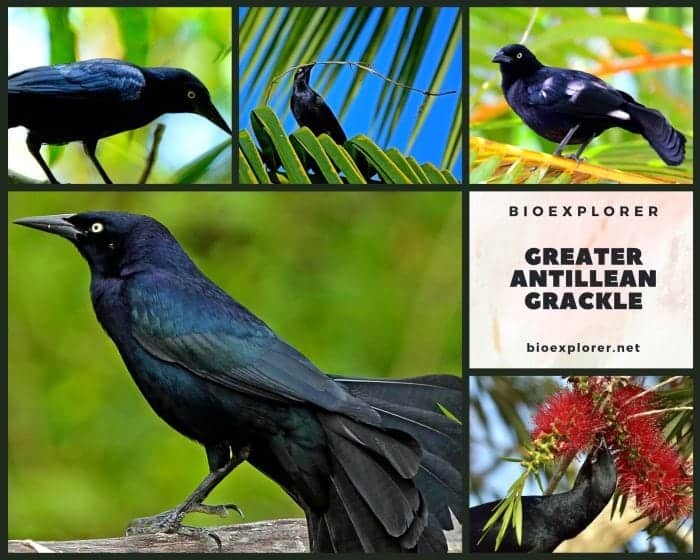
| Animalia | Passeriformes | Icteridae | Quiscalus | Quiscalus niger |
Meet the glossy black singer of the Antilles: Greater Antillean grackle (Quiscalus niger). This large, gregarious songbird species is a common sight in heavily settled areas across the islands of the Caribbean.
With its yellow eyes contrasting dramatically against jet black plumage, the grackle cuts a sharp silhouette as it struts across lawns or perches on power lines. Its raucous calls ring out as the birds gather in noisy flocks, foraging on the ground or defending breeding territories.
Found natively in the Greater Antilles – Cuba, Jamaica, Hispaniola, and Puerto Rico as well as smaller nearby islands, the Greater Antillean grackle plays a unique ecological role. As an omnivorous, opportunistic feeder, these birds help control invertebrate and small vertebrate populations while dispersing seeds.
And as a common backyard visitor, even in dense cities, the grackle interacts closely with humans across its island range. This accessibility makes the grackle an ideal ambassador for wildlife native to the Caribbean.
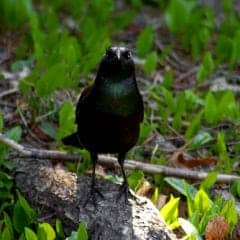

- Common Name(s): Greater Antillean Grackle, Kling-Kling, Chinchilín, Ching Ching, Chango
- Family: Icteridae
- Body Dimensions: 27 cm (male), 24 cm (female)
- Male Plumage Color(s): Glossy Black
- Female Plumage Color(s): Less Glossy Black
- Habitat: Heavily Settled Areas
- Diet: Omnivorous (Fruits, Plants, Small Vertebrates, Invertebrates)
- Native Countries: Greater Antilles islands, nearby smaller islands
- Continent(s): North America
- Taxonomy Classification Year: 1783
- Taxonomist(s): Pieter Boddaert
Types of Greater Antillean grackles
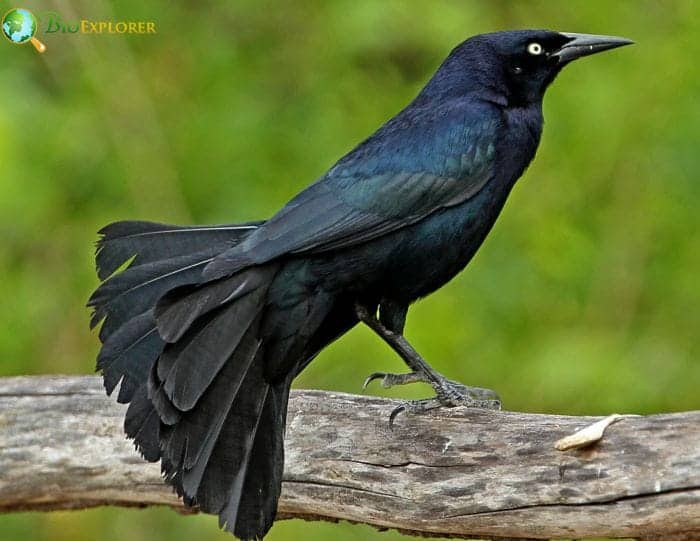
The Greater Antillean grackle belongs to the diverse Icterid family of songbirds, which includes New World blackbirds, orioles, cowbirds, and other grackle species. Within the genus Quiscalus, the grackle is classified as Quiscalus niger.
This species has further differentiated into 7 recognized subspecies, each located on a distinct island or island group:
- Quiscalus niger niger: The nominate subspecies found on Hispaniola.
- Quiscalus niger caribaeus: Occurring in western Cuba.
- Quiscalus niger gundlachii: Living in central/eastern Cuba.
- Quiscalus niger caymanensis: Only on Grand Cayman Island.
- Quiscalus niger bangsi: Restricted to Little Cayman Island.
- Quiscalus niger crassirostris: Native to Jamaica.
- Quiscalus niger brachypterus: Found only in Puerto Rico.
The various subspecies can be distinguished by differences in body size, tail shape/length, and how glossy their black plumage appears. For example, Quiscalus niger brachypterus in Puerto Rico has a shorter, rounder tail and wings than the long, graduated tail of Quiscalus niger crassirostris grackles in Jamaica. And Quiscalus niger niger grackles in Hispaniola show more iridescent sheen to their feathers than populations further west.
These unique island forms of the grackle likely diverged in isolation after colonizing different Greater Antillean islands. Their taxonomic story echoes much of the natural history of the Caribbean.
![]()
Greater Antillean Grackle’s Physical Characteristics
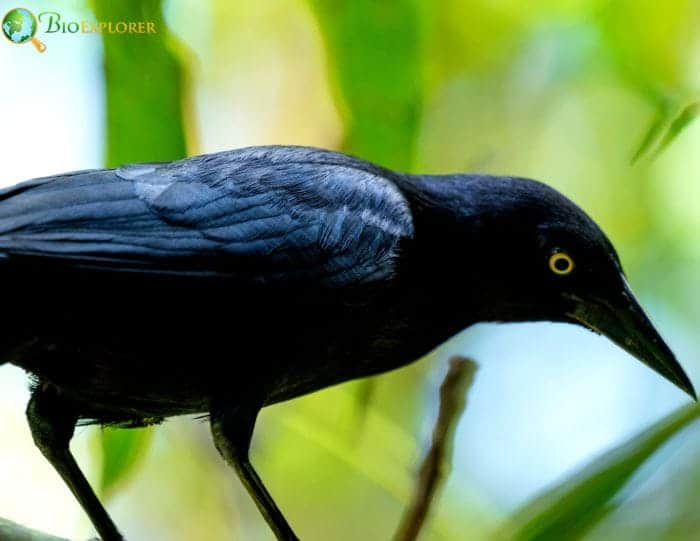
- The Greater Antillean grackle is a relatively large songbird, with males reaching around 27 cm (11 inches) long and females averaging 24 cm (9.4 inches). Average weight ranges from 62-73 g (2.2-2.6 oz). .
- As their Latin name niger (black) indicates, grackles sport all-black plumage. But the sheen of these black feathers differs subtly between the sexes and subspecies.
- Males tend to show a deeper glossy black tone, especially on the head and breast, contrasting with their bright yellow eyes. Females exhibit a slightly duller, less iridescent black overall. However, females—especially mature ones—have beautiful silver-speckled undertail coverts.
- Both sexes share the grackle’s iconic keel-shaped tail, though this steering rudder is more pronounced on males. Relative tail length also varies among the subspecies.
- The white undertail becomes visible in flight, creating a flashy contrast against the bird’s otherwise dark coloration. Flocking grackles wheeling through the sky offer quite a sight!
- On the ground, the grackle’s jet-black figure stands out distinctly. Combined with its strident vocalizations, the grackle is an unmistakable sight and sound across the settled areas and open habitats of Caribbean islands it calls home.
![]()
Greater Antillean Grackle Habitats
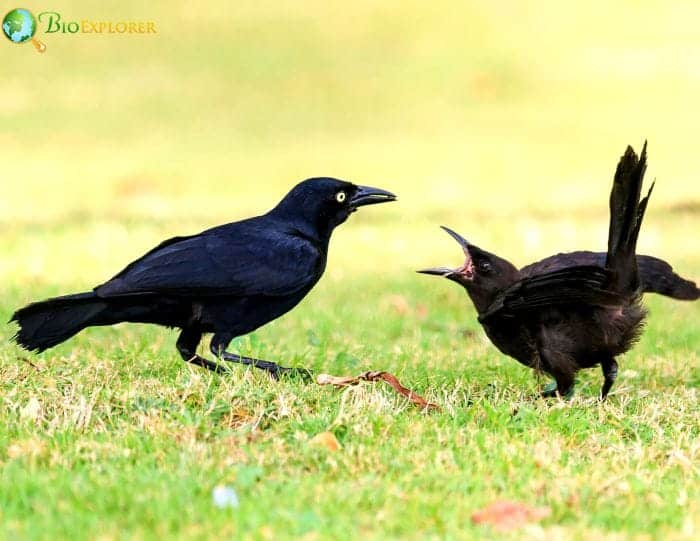
The Greater Antillean grackle thrives across various habitats on islands in the Caribbean region. It often occurs in areas heavily influenced by humans, even thriving in urban and suburban developments.
- In cities, grackles frequent parks, streets lined with trees, and backyards. They often nest on buildings and forage for scraps. Beyond the city limits, grackles occupy more open areas like pastures, agricultural lands, coastal scrub, and beaches.
- Essentially, the grackle exploits any habitat that provides elevated perches like powerlines or scattered taller trees. From these vantage points, it scans for food on the ground while staying safe from predators.
- Access to grassy areas for foraging insects and trees bearing fruit or nesting cavities are other habitat musts.
![]()
What Do Greater Antillean Grackles Eat?
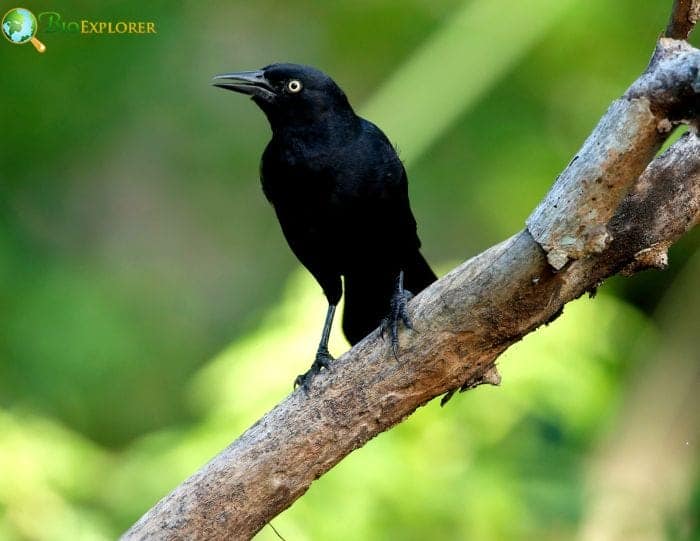
The Greater Antillean grackle is best described as an opportunistic generalist regarding diet. Equipped with a strong beak, the grackle capably handles various food sources.
- Insects and other arthropods make up a substantial portion of the grackle’s nutrition.
- Patrolling open grassy areas in loose flocks, grackles probe the ground to flush out crickets, beetles, grubs, spiders, and more.
- Grackles also eagerly consume fruit and seeds when available.
- Figs, mangoes, citrus fruits, guavas, papayas, and berries have all been recorded as grackle foods. The birds play a role in distributing seeds through their droppings.
Another key component of the grackle diet is small vertebrates.
- Grackles prey upon tree frogs, anoles, small snakes, and nestling birds. Their opportunism also leads them to eat scraps and trash associated with human habitation.
- With flexible food preferences spanning fruit to French fries, the Greater Antillean grackle makes the most of the resources available across its Caribbean range!
![]()
What Eats Greater Antillean Grackles?
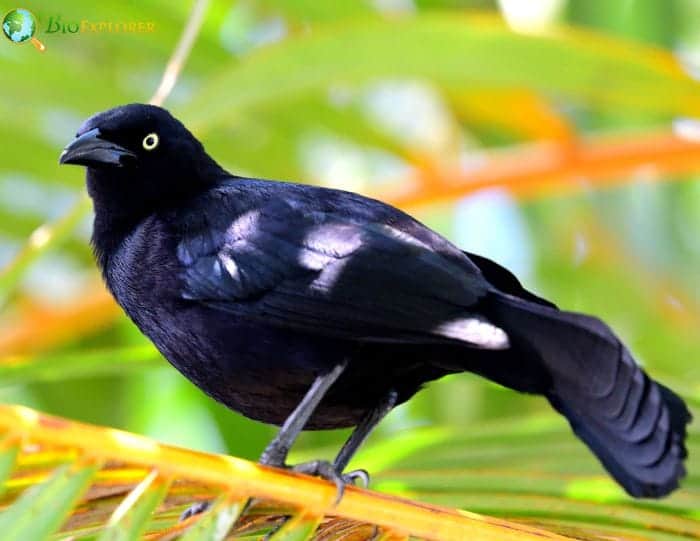
As a common, widespread bird, adult Greater Antillean grackles likely experience relatively low predation pressure even in human-populated areas. However, eggs and chicks in nests may be more vulnerable.
Potential grackle nest predators across their Caribbean range could include:
- Birds of prey: Hawks, falcons, owls, and Vultures may prey on adults, chicks, or eggs.
- Mammals: Arboreal species like raccoons or coatis could raid nests. Feral cats also pose a threat.
- Snakes: Boa constrictors and other climbing snakes sometimes raid bird nests.
The grackle’s adaptation to disturbed habitats with sparser predator populations and their social behavior helps adult birds avoid predation. Losing some chicks or eggs to predators is likely a tolerable cost the grackle population can withstand.
Based on 2018 assessment, IUCN has classified this Grackle as Least Concern[1].
![]()
Greater Antillean Grackle Behavior and Social Structure
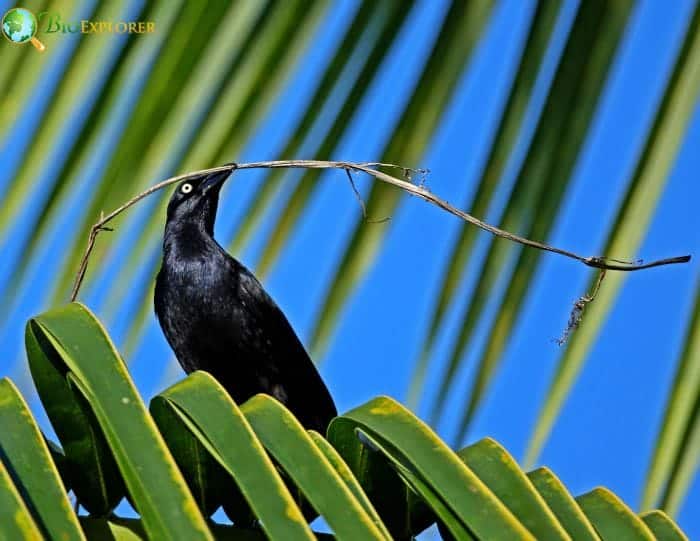
The Greater Antillean grackle exhibits highly gregarious behavior. The birds spend much time in small to large flocks, especially foraging.
- Flock sizes range from a handful to 100+ individuals, mixing males and females. First-year juveniles may also join flocks after fledging the nest. Grackles roost communally in trees or on rooftops at night when not actively feeding.
- Roosting aggregations can contain several thousand grackles! The birds jostle noisily for the best protected perching spots.
- Within flocks, grackles communicate through a repertoire of squeals, croaks, and chatter.
- To human ears, the noises seem chaotic. However, they serve to maintain flock cohesion. Grackles also vocalize aggressively when defending feeding or nesting territories.
![]()
Greater Antillean Grackle Nesting and Breeding Patterns
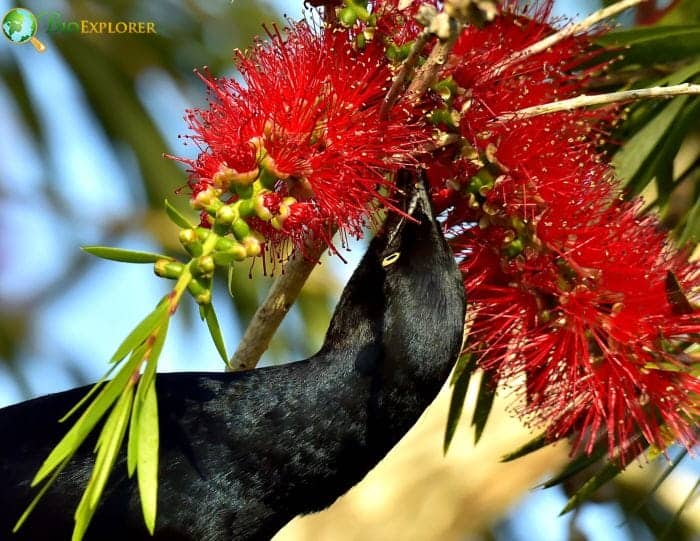
- The Greater Antillean grackle builds an open-cup nest typically high up in palm fronds, the fork of a tree, or on a structure. Nest locations range from 10 to 30 feet high, helping protect from predators.
- Both male and female grackles participate in nest construction. The bulky nests are woven from various materials, including sticks, grass, plastic fibers, paper, and mud.
- Inside this sturdy basket, a typical grackle clutch contains 3 to 5 eggs. The female incubates them for around 12-14 days before they hatch.
- Both parents share feeding duties for the noisy nestlings. Young grackles typically fill the nest at 22-24 days old but may still depend on parents for a period afterward.
In much of its range, the Greater Antillean grackle breeds in a defined spring season. But timing and duration vary by location:
- Jamaica: January-June peak
- Cuba: March-August
- Hispaniola: April-July
- Puerto Rico: March-July
![]()
Comparison with Similar Species
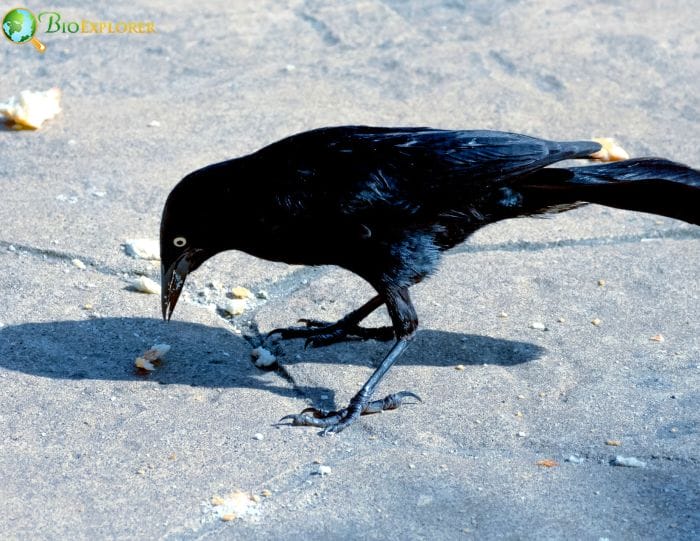
With its jet-black plumage and long, graduated tail, the Greater Antillean grackle shares some similarities with other icterids, like the Common Grackle of North America or the Carib Grackle of South America.
Key differences help distinguish it from these relatives:
- Lacks the iridescent blue-purple sheen on the head and body found in Carib Grackles.
- Greater Antillean Grackle has yellow rather than pale yellow or white eyes.
- Tail shape in flight is more rounded fan vs. rectangular in Common Grackle.
The Greater Antillean Grackle’s range is also restricted to Caribbean islands. So, any all-black grackle spotted on the North or South American mainlands can be safely ruled out!
Carib Grackle
- Bright purple-blue iridescence on the head/body of Carib Grackle, lacking in duller Greater Antillean.
- Carib exhibits a more graduated tail shape with outer feathers up to 4 inches longer.
- Carib vocalizations are higher, more squeaky-sounding.
- Restricted to South America; ranges don’t overlap.
Common Grackle
- Common Grackle shows contrasting bronzy iridescence on the head and neck.
- Tail shape more rectangular in flight on Common.
- Common Grackle is larger with heavier bill; females paler in color.
- Range confined to North America.
Shiny Cowbird
- Female cowbird grayish-brown rather than black.
- Shorter tail and thicker neck than long-tailed grackle.
- Walks on the ground; grackle more arboreal.
- Parasitizes host nests rather than building its own.
![]()
Greater Antillean Grackle Fun Facts
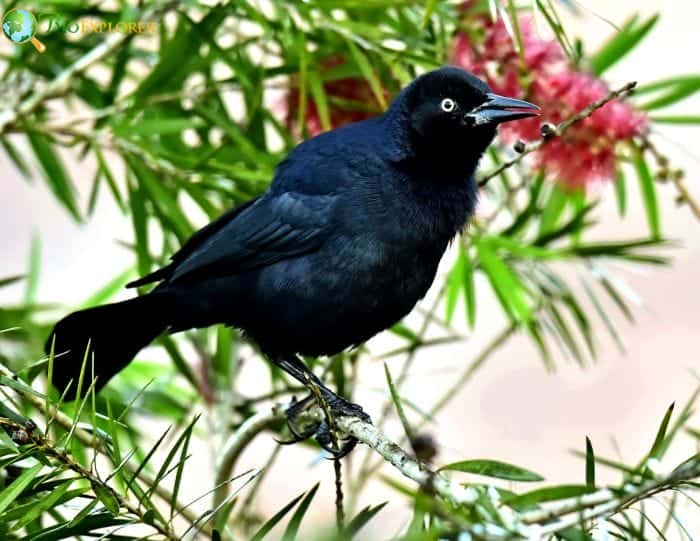
- The Greater Antillean grackle’s scientific name Quiscalus comes from the Latin term for a kind of thrush, while niger means black or dark.
- Its common name refers to the Greater Antilles Island group in the Caribbean where it occurs. This differentiates it from the smaller Lesser Antilles chain.
- Various local names like “chango” in Puerto Rico or “ching ching” in the Cayman Islands try mimicking the raucous grackle vocalizations.
- The grackle’s keel-shaped tail helps it steer and maneuver adeptly while flying through its island habitat.
- Grackles practice “anting” perching over fire ants to let the insects swarm through their feathers! The ants’ secretions may help deter lice and other feather parasites.
- Though the grackle thrives around human habitation, it faces threats like habitat loss, climate change, and biomagnification of environmental toxins up the food chain.
- Classification continues evolving. Some experts recently categorized the Greater Antillean Grackle as a subspecies of the Great-tailed Grackle. But this change is still disputed.
- The grackle was first scientifically described by 18th century naturalists like Hans Sloane and Georges-Louis Leclerc.
- It is a common host for infecting mosquitoes with West Nile virus in Puerto Rico.
- Male grackles put on an acrobatic courtship display, fanning their long tail vertically while strutting and puffing their glossy feathers to entice females.
- The grackle’s affinity for berries helps disperse seeds far and wide through their droppings; they play an unsung role in enriching new vegetation growth across the islands!
![]()
Frequently Asked Questions

What is the scientific name of the greater antillean grackle?
The scientific name of the greater antillean grackle is Quiscalus Niger. It was named by Pieter Boddaert in 1783.
Where is the grackle found?
The grackle is found throughout the Greater Antilles, in countries such as the Dominican Republic. In Puerto, the bird is known as “El Chango”.
What are some notable features of the greater antillean grackle?
The greater antillean grackle is similar in color with other grackles but one key feature is its large rudder-like tail. Its other distinguishing factor is its yellow eye, unlike other grackles which have a dark eye.
Does the female grackle look different from the male?
Yes, the female grackle is slightly different as it has some non-black body parts which are less glossy and more purplish.
What does a grackle eat?
The Antillean grackle is a generalist eater. It eats fruits along with other plant matter and small animals like lizards. This diet is flexible, making grackle often found near Mangrove and other lowland areas with food sources.
Is the grackle a social bird?
Yes, the grackle is a rather large and gregarious bird. It often found in large roosts.
Does the greater antillean grackle have many subspecies?
Yes, the greater antillean grackle, Quiscalus Niger, indeed has 7 subspecies.
What is the conservation status of the greater antillean grackle?
According to the IUCN Red List and BirdLife International, the bird is not considered to be under any threat and has been classified as Least Concern due to its wide distribution as of 2018 assessment.
Has the behavior of Grackle been ever documented scientifically?
Yes, the unique behavior of this bird has been documented on eBird platform extensively. Particularly, its “ruff-out” and kling-kling sound are noteworthy.
Are grackles native to any other regions?
Besides being found throughout the Greater Antilles, grackles are also common on the island of Vieques, and they have a keel in the center of their tails which other grackles do not have.
Conclusion
The Greater Antillean grackle is a unique Caribbean songbird at home among humans across its island nations. With its boisterous behavior mirroring the vibrant culture of the Antilles, this opportunistic bird adapts readily to the changes brought across its lands, from sugar plantations to bustling modern cities.
Yet the grackle remains an untamed nature – its piercing cries, iridescent feathers, and willingness to consume anything across the landscape. In balancing disturbance and wilderness, niche urbanite and adaptable generalist, the Greater Antillean grackle epitomizes the modern age of wildlife alongside civilization across these islands.
Understanding and supporting species like the grackle helps ensure a thriving biodiversity persisting amidst human activity. Whether we admire its rakish good looks or rue its loud voice, by appreciating the place even “common” species hold in Caribbean environments, we ultimately cultivate compassion for ecosystems that sustain us all.
![]()











